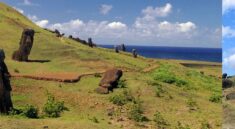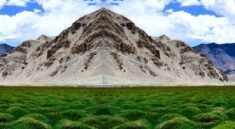Marsa Alam, nestled along the Red Sea in southeastern Egypt, is a picturesque resort town celebrated for its unspoiled beaches, crystal-clear waters, and vibrant coral reefs. A haven for divers and snorkelers, Marsa Alam offers access to breathtaking marine life, including colorful corals and diverse fish species. With a commitment to marine conservation, the region provides a tranquil escape, maintaining a more relaxed atmosphere compared to other Red Sea destinations. Boasting a desert backdrop, Marsa Alam also appeals to nature lovers, featuring attractions like Wadi El Gemal National Park and ancient mining sites. Accessible through Marsa Alam International Airport, this coastal gem welcomes visitors to a world of sun-soaked adventure and natural wonders.
How to get there
To reach Marsa Alam, you can utilize various transportation options, including air travel and road transportation. Here’s how to get to Marsa Alam:
- By Air:
- Marsa Alam International Airport (RMF): The most convenient way to reach Marsa Alam is by flying. Marsa Alam International Airport (RMF) serves the region and is well-connected to major cities in Egypt and some international destinations.
- Several airlines operate flights to Marsa Alam, offering both domestic and seasonal international flights.
- Domestic Flights:
- If you are already in Egypt, you can catch a domestic flight to Marsa Alam from major airports like Cairo International Airport or Hurghada International Airport. Flight availability may vary depending on the time of year.
- Airport Transfers:
- Many hotels and resorts in Marsa Alam offer airport transfer services. Check with your accommodation provider to see if they provide transportation from the airport to your destination.
- By Road:
- While less common, you can also reach Marsa Alam by road. However, this option is more time-consuming and typically involves a long-distance bus or private car.
- Road trips may be an option for those traveling from nearby cities like Hurghada or Luxor, but the journey can be lengthy.
- Tour Packages:
- Some travelers prefer to book tour packages that include transportation, accommodation, and possibly guided activities. These packages often offer a convenient and comprehensive way to explore Marsa Alam.
Before planning your trip, consider the most convenient mode of transportation based on your location and preferences. Flight availability, especially during peak tourist seasons, should be checked in advance. Additionally, if you’re booking a package or staying at a resort, inquire about transportation options provided by your accommodation.
Things to do
Marsa Alam offers a variety of activities for visitors, ranging from water sports and diving to exploring the natural beauty of the region. Here are some popular things to do in Marsa Alam:
- Diving and Snorkeling:
- Explore the vibrant underwater world of the Red Sea by engaging in diving or snorkeling activities. Marsa Alam is known for its pristine coral reefs, diverse marine life, and clear waters.
- Marsa Alam National Park:
- Visit the Marsa Alam National Park, which includes the protected marine areas along the coastline. Enjoy the natural beauty and diverse ecosystems, and perhaps participate in organized eco-tours.
- Wadi El Gemal National Park:
- Explore Wadi El Gemal National Park, a protected area known for its stunning landscapes, including mountains, canyons, and coastal areas. The park is rich in biodiversity and offers opportunities for hiking and wildlife observation.
- Desert Safari:
- Embark on a desert safari to experience the unique charm of the surrounding desert landscape. Many tour operators offer excursions to explore the desert, providing a chance to witness the beauty of the arid terrain and perhaps enjoy a traditional Bedouin experience.
- Quad Biking and Camel Riding:
- For adventure seekers, consider quad biking across the desert or enjoying a more traditional experience with camel riding. These activities provide a different perspective of the Marsa Alam landscape.
- Dolphin Watching:
- Take a boat trip for dolphin watching in the Red Sea. Marsa Alam is known for its frequent dolphin sightings, offering a memorable experience for nature enthusiasts.
- Kite Surfing and Wind Surfing:
- With its windy conditions, Marsa Alam is an ideal destination for kite surfing and wind surfing. Many water sports centers offer equipment rental and lessons for beginners.
- Relax on the Beach:
- Unwind and soak up the sun on the beautiful beaches of Marsa Alam. Many resorts have private beach areas where you can enjoy the Red Sea’s warm waters and picturesque surroundings.
- Mangrove Forests:
- Explore the mangrove forests near Marsa Alam, such as those in the Wadi El Gamal area. These unique ecosystems provide a habitat for diverse marine life.
- Local Markets and Shopping:
- Visit local markets to experience the culture and shop for souvenirs. You can find traditional handicrafts, spices, and other items unique to the region.
Remember to check the weather conditions and the best times for specific activities, especially water-related ones, to ensure an optimal and enjoyable experience during your stay in Marsa Alam.
Things not to forget
When traveling to Marsa Alam or any destination, it’s important to be well-prepared. Here’s a checklist of things not to forget:
- Travel Documents:
- Passport and visa (if required).
- Flight tickets and itinerary.
- Travel insurance details.
- Health Essentials:
- Necessary vaccinations or health precautions.
- Prescription medications and a basic first aid kit.
- Sunscreen with high SPF, lip balm, and after-sun lotion.
- Insect repellent.
- Clothing and Accessories:
- Lightweight and breathable clothing suitable for warm temperatures.
- Swimwear for beach activities.
- Comfortable walking shoes or sandals.
- Hat, sunglasses, and a light scarf for sun protection.
- Waterproof jacket or poncho for unexpected rain.
- Electronics and Gadgets:
- Camera or smartphone for capturing memories.
- Chargers for your devices and a power bank.
- Adapters if traveling from a country with different plug types.
- Water and Hydration:
- Reusable water bottle to stay hydrated, especially in the warm climate.
- Money and Banking:
- Sufficient local currency (Egyptian Pounds) in small denominations.
- Credit/debit cards.
- Notify your bank about your travel plans to avoid any issues with card transactions.
- Travel Comfort:
- Neck pillow and travel blanket for comfort during flights.
- Travel-sized toiletries.
- Personal hygiene items.
- Outdoor and Adventure Gear:
- Snorkeling or diving gear if you have your own.
- Water shoes for beach and water activities.
- Hat and sunglasses for protection during desert excursions.
- Navigation and Information:
- Maps or navigation apps for exploring the area.
- Information about local emergency contacts and services.
- Entertainment and Leisure:
- Books, e-reader, or travel games for downtime.
- Music playlist or podcasts for travel.
- Respect for Local Culture:
- Modest clothing, especially if visiting religious or cultural sites.
- Awareness of local customs and traditions.
- COVID-19 Precautions:
- Face masks and hand sanitizer.
- Verify and adhere to any travel restrictions or health protocols in place.
Before your trip, it’s always a good idea to double-check specific requirements or recommendations based on the season, local conditions, and any recent developments in the destination. Planning ahead ensures a smoother and more enjoyable travel experience.
Best time to visit
The best time to visit Marsa Alam depends on your preferences for weather, activities, and the overall experience you seek. Generally, Marsa Alam has a desert climate with hot temperatures throughout the year. Here are considerations for different times:
- Peak Season (November to March):
- This period is considered the peak tourist season due to the milder temperatures. Daytime temperatures range from 20 to 30 degrees Celsius (68 to 86 degrees Fahrenheit).
- It is an excellent time for beach activities, water sports, and diving.
- The Red Sea offers clear visibility for diving and snorkeling during these months.
- Low Season (June to August):
- Summer months are characterized by high temperatures, often exceeding 40 degrees Celsius (104 degrees Fahrenheit).
- This is the low season due to the extreme heat, but it can be suitable for those who enjoy the warmth and want to avoid crowds.
- Be prepared for intense sunlight, and take necessary precautions against the sun.
- Shoulder Seasons (April-May, September-October):
- Shoulder seasons offer a balance between milder temperatures and fewer crowds.
- April-May and September-October are transitional periods with pleasant weather for outdoor activities.
- These months are ideal for those seeking a quieter experience while still enjoying warm temperatures.
- Whale Shark Season (October to March):
- If you’re interested in whale shark sightings, the period from October to March is considered the best time. These gentle giants are more commonly spotted during these months.
- Cultural Considerations:
- Consider local cultural and religious events when planning your visit. For example, Ramadan, the Islamic holy month, can impact the availability of services and activities.
It’s crucial to be aware of the specific weather conditions and your preferred activities when planning your trip. Keep in mind that during the peak summer months, the temperatures can be quite challenging for outdoor activities, so if you’re not accustomed to high heat, it may be advisable to choose a milder time to visit. Always check for any travel restrictions or considerations, especially in light of evolving global conditions.
Does Marsa Alam have an airport?
Yes, Marsa Alam has an international airport called Marsa Alam International Airport (RMF). The airport is located approximately 60 kilometers northwest of the city of Marsa Alam, making it a convenient gateway for travelers heading to the resort town and surrounding areas.
Marsa Alam International Airport (RMF) serves as a key transportation hub for tourists visiting the Red Sea region, particularly those interested in exploring the beautiful beaches, coral reefs, and other attractions in and around Marsa Alam. The airport facilitates both domestic and international flights, connecting the area to major cities within Egypt and some international destinations.
Travelers flying into Marsa Alam International Airport can easily access the resort town by arranging airport transfers, taxis, or rental cars available at the airport. The airport has facilities and services to accommodate the needs of travelers, including lounges, duty-free shops, and car rental agencies.
What is the coldest month in Marsa Alam?
Marsa Alam experiences a desert climate, characterized by hot temperatures throughout the year. While there are variations in temperature, the term “cold” is relative in this context, as the climate is generally warm to hot. The coolest months in Marsa Alam are during the winter season.
The winter season in Marsa Alam typically occurs from December to February. During this period, temperatures can be relatively milder compared to the hotter months. The coldest month, if we consider the term “cold” in the context of a desert climate, is usually January.
In January, you may experience daytime temperatures ranging from around 18 to 25 degrees Celsius (64 to 77 degrees Fahrenheit), while nighttime temperatures can drop to around 10 to 15 degrees Celsius (50 to 59 degrees Fahrenheit). While these temperatures are cooler compared to the summer months, they are still relatively mild compared to what is traditionally considered “cold” in other climates.
It’s important to note that even during the winter months, Marsa Alam remains a destination with generally warm and pleasant weather, making it suitable for outdoor activities and water sports.
Image credits: upload.wikimedia.org





